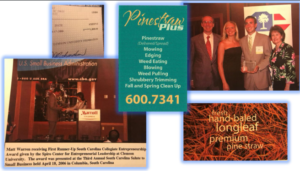Marketing Goals: 1) to have a campaign ready database; 2) Establish a Cadence and roll it out to the database
Growing up with each of my start up businesses, I worked very hard to maintain a “campaign ready” database. What does that mean? It means that I tried to always maintain and update contacts as they came so that whenever the time came to send out a marketing letter or postcard, I was ready.
My dad has said before, there is a fine line of having a really solid database that is totally current and up-to-date, and balancing actually reaching out to clients. We can spend all of our time just updating our database and our clients don’t ever get to actually know about us. There has to be a balance of sales AND marketing. Obviously, I cannot call on clients if my database is out of date and the phone numbers, emails and addresses are old and obsolete, but on the other hand, if I spent all my time updating and verifying data for the database, the poor clients will never get the opportunity to use my product or service because I’m just worried if I have their phone number and address correct.
LinkedIn Sales Navigator is a huge tool for me to be able to look up a client who’s email has bounced because they have found a new job or who’s postcard is returned.
On that note, side comment, ALWAYS spend a little bit more money on an actual stamp and the time to put the stamp on the mailer because we absolutely want the returned pieces back. If you just use a mail house and they put a meter symbol on the piece, you never get the address issues in order to correct them. Worst piece of that is that you think you are sending things to them when actually, they moved and you have no idea.
Marketers are well aware of the many definitions of the word “campaign.” I build campaigns to promote products or services, but I also use them to track first-touch and relate them to my sales funnels.
Once I have the database uptodate with all of the fixes that I know of, then I can put the database into a cadence. A cadence is a set of differnent market media or techniques to hit a customer in sequence. For example, one cadence that I have used before is something like: First, we are going to send the prospect a postcard to their address; Second, we are going to send their email our monthly e-newsletter; Third, I am going to invite them to connect on LinkedIn; Fourth, I am going to reachout and call them.
The nice thing about this type of cadence, is that they have seen something about our company before I try to cold call them. There is a familiarity with my product or service before I try and call them.
“In general, all marketing campaigns have some basics in common. They are built in order to promote a product or service via multiple channels, there is an end goal to be met, and whether that goal has been achieved is measured through pre-defined metrics.
Speaking of campaign member statuses—this is a great way to identify how campaign members are interacting with your campaigns; for example, did a lead or contact only register for an event or actually attended?”
https://www.pardot.com/blog/pardot-campaigns-vs-salesforce-campaigns/
The Ultimate Marketing Campaign Plan Template
Here is a list of potential business goals:
- Branding – To increase awareness of your company, product and/or people in your market; to communicate the value you provide and what you stand for.
- Generate new leads – To generate new leads.
- Qualify leads – To better qualify and rank leads so you can segment them and then follow up based on their timeframe and likelihood of buying.
- Nurture existing leads – To communicate with leads that are in the pipeline but may not be ready to buy or to take the next step; a nurturing campaign reminds them of your value and provides information that can help move them along.
- Direct sales – To close deals within a short time period – a campaign to encourage people to “buy now.”
- Cross-sell to existing customers – To encourage current customers to buy related products or services.
- Up-sell existing customers – To encourage current customers to upgrade their existing product, to increase the quantity or frequency of their purchases.
- Nurture existing customers – To communicate with existing customers and reinforce the value you provide.
- Generate referrals – To encourage customers or prospects to provide referrals.
- Training – To train current customers, new customers, or even prospects to use your product; to train distributors, channel partners, and even your own employees.
Here are potential media:
- Online Advertising – Facebook, Twitter, LinkedIn or other ad networks
- Website – A blog post, microsite or special landing page
- Video – Hosted on your site or on YouTube or Vimeo or Facebook or Twitter
- Social Media – Any or all of the communities where your audience participates
- Email – Sent to your existing list or rent a vetted list
- Email Newsletters – Banner ads or sponsorships
- PR – Pitch your story to journalists or bloggers
- Search Engines – Use paid search or SEO for your campaign content
- Print – Advertise in magazines or trade publications
- Events – Hold a special event or seminar or be creative at your annual trade show
- Podcast – Promote it on SoundCloud
- Webinars – Host an online presentation via GoToWebinar
- TV – Advertise on a highly targeted cable show
- Radio – Sponsor an industry talk show
- Outdoor – Create a building wrap or special display
